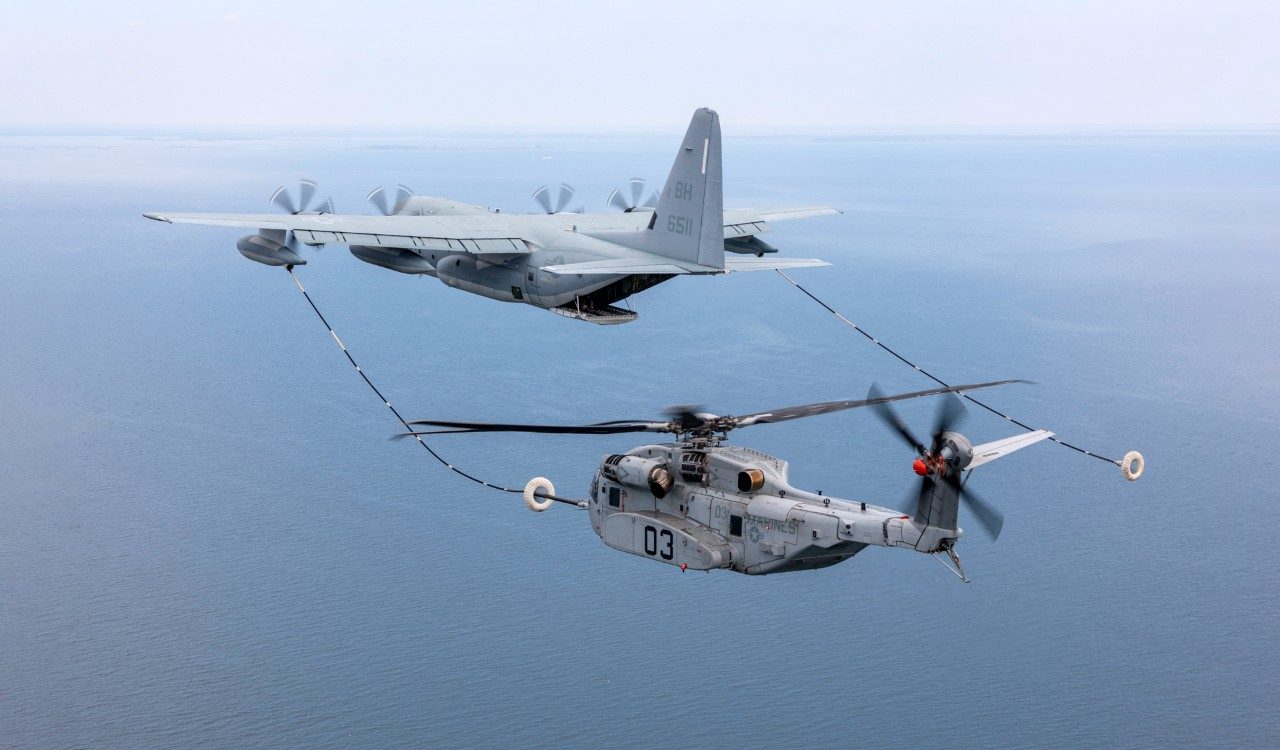It was nothing but net as Lockheed Martin’s legendary Hercules teamed up with the all-new CH-53K helicopter to mark a first for the King Stallion.
In a flight lasting 4.5 hours over the Chesapeake Bay in early April, the CH-53K successfully completed an air-to-air refueling (AAR) test with the help of a U.S. Marine Corps KC-130J Super Hercules aerial refueling tanker. The CH-53K repeatedly demonstrated its ability to capture and “plug” the drogue, withstanding turbulent air and the force on the refueling probe at increased closure rates.
Sikorsky Test Pilot Rob Pupalaikis was in the cockpit.
“Air-to-air refueling is a decisive force multiplier, and proving this capability on the CH‑53K King Stallion significantly increases the combat potential for the U.S Marine Corps' newest workhorse in its stable,“ he said. “The aircraft performed flawlessly during the testing and met all of the program objectives.”
This was a first for the King Stallion, but it had the experienced KC-130J to guide the way.
The KC-130J is the current production model and a variant of the C-130 Hercules, produced by the Lockheed Martin Aeronautics team. Known as a true force multiplier, the KC-130J refuels fixed wing, rotary wing and tilt-rotor aircraft as well as conducts rapid ground refueling. The Hercules family of aircraft has served as the standard for tactical air refueling for almost 60 years.
The U.S. Marine Corps operates the largest global KC-130J fleet (soon to be flown by seven global operators), which also relies on the KC-130 to refuel its F-35C jets.
A hallmark of the KC-130 is its ability to provide AAR to almost every rotary wing platform in the world through its hose and drogue aerial refueling system.
"The KC-130 not only has a long history serving the Marine Corps, but also providing critical fuel requirements to every Sikorsky platform, now to include the CH-53K,” said Rod McLean, vice president and general manager of Aeronautics’ Air Mobility & Maritime Mission line of business. “There’s much to be proud of in this milestone for the Marine Corps, Lockheed Martin and Sikorsky. This is another moment that once again highlights the workhorse commonality and proven capabilities shared by the Hercules aircraft and Sikorsky helicopters.”
Air to Air Refueling: Critical to the Mission
The ability to refuel in midair is critical to expanding the King Stallion’s mission options across all U.S and allied military services. So, when it came to pairing this newbie with a mentor, the Hercules just made sense. With more than 65 years of C-130 operation and customers around the world using the KC-130 for refueling, this freighter knows a thing or two about midair ops.
The successful air-to-air refueling test reinforces the superior capabilities of the CH-53K heavy-lift helicopter and its ability to carry more Marines, cargo and equipment over longer ranges and in more challenging environments than any other rotorcraft in the world.
As the only fully marinized heavy-lift helicopter, this includes open waters, supporting advanced base operations from ship to shore.
“The aircraft went to the tanker and it was very successful, proving it is a long-range vertical logistic workhorse,” said Col. Jack Perrin, H-53 heavy-lift helicopters (PMA-261) program manager. “The ‘K’ is the long-range enabler that we need now and into the future.”

CH-35K helicopter air-to-air refueling (AAR)
What a Difference the 'K' Makes
Sikorsky Test Pilot Rob Pupalaikis says the CH-53K fly by wire flight controls will be a positive workload reducer for the fleet.
“The unique upper modes of the fly by wire flight control architecture were designed in part for the workload intensive helicopter air to air refuel mission; and through flight testing, the advanced flight control system has demonstrated the potential to reduce the pilot workload relative to the legacy CH-53E.”
CH-53K Program Progress
There are six King Stallion in the flight test program with over 1,800 flight hours logged to date.
In addition to the refueling test, the team recently completed automatic blade fold testing as part of the preparation for initial sea trials later this year. The team is scheduled to return to the U.S. Army Yuma proving grounds for expanded degrade visual environment testing this summer.
While the King Stallion and Hercules are new acquaintances right now, this recent test proves they can operate as a team for the long haul. It’s only a matter of time before we see them flying high together again.




